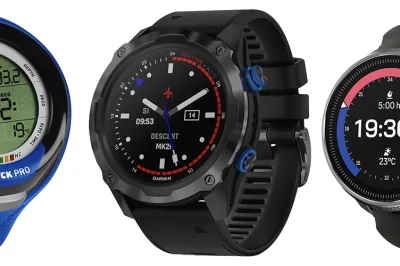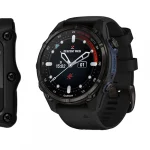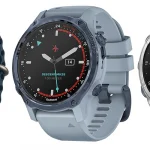Understanding Dive Computer Basics

Table of Contents
- Understanding Dive Computer Basics
- The Misguided Savings Mindset
- Pitfalls of Buying on Price Alone
- The Tech Revolution: Dive Computers in 2025
- Investment in Quality: A Smart Diver’s Choice
- Debunking Cheap Dive Computer Advantages
- Trendsetter’s Guide to Buying Dive Computers
- Hidden Costs: A Deep Dive into Pros and Cons
Introduction
Scuba diving is an exhilarating experience, but safety and cost-effectiveness are paramount in enjoying it to the fullest. This post delves into why opting for a cheaper dive computer might have hidden long-term costs, potentially costing Florida divers up to three times more.
Understanding Dive Computer Basics
Common misconceptions about affordable dive computers often lead divers to overlook critical features, putting their safety at risk. Here are some prevalent misunderstandings, their realities, and the potential hazards associated with them:
1. “Entry-Level Computers Lack Critical Safety Features”
Myth: Many believe that basic models do not provide essential functions like ascent rate alerts or depth tracking.
Reality: Modern entry-level computers include:
- No-decompression limit (NDL) tracking to avoid nitrogen supersaturation.
- Ascent rate monitoring (standard across price tiers).
- Depth and time logging for post-dive analysis.
Risks: Underestimating these features may lead divers to ignore crucial safety protocols, increasing the likelihood of decompression sickness (DCS).
2. “Nitrox Compatibility Requires Advanced Models”
Myth: A common belief is that only high-end computers can handle enriched air diving.
Reality: Most entry-level devices can calculate safe depths for up to 40% oxygen mixes, adjusting dive limits to mitigate oxygen toxicity risks.
Risks: Misusing Nitrox without proper adjustments could lead to serious complications, including oxygen toxicity or reduced bottom time.
3. “Ascent Rate Alerts Are for Advanced Divers Only”
Myth: Some assume that ascent monitoring is exclusive to premium models.
Reality: All modern dive computers include ascent rate alerts, which help prevent rapid ascents that could lead to DCS.
Risks: Ignoring these alerts due to misconceptions about device capabilities increases the risk of injury.
4. “Data Logging Is Superfluous for Beginners”
Myth: Many novice divers overlook data logging as unnecessary.
Reality: Entry-level models store critical dive profiles for manual review, aiding in skill development and safety.
Risks: Skipping this analysis deprives divers of valuable insights into their dive behaviour, potentially leading to unsafe practices.
Additional Risks and Considerations
- Algorithm Variability: Different dive computers can yield varying NDLs, creating inconsistencies during group dives.
- Unaccounted Variables: Computers do not measure body fat, age, or ambient temperature — all factors that influence gas loading and DCS risk.
- NDL Boundary Pushing: Remaining close to NDLs does not eliminate risk; some computers recommend safety stops to manage residual gas exposure.
Focusing on key features such as ascent rate alerts, Nitrox support, and manual data logging can enhance safety and performance during dives.
The Misguided Savings Mindset
Choosing the right dive computer is crucial for both safety and enhancing your diving experience. While the temptation to save money on a cheaper model is common, this decision can lead to significant long-term costs and risks.
Limited Future-Proofing for Advanced Diving
Budget dive computers often lack essential features necessary for more advanced diving techniques. Many inexpensive options fail to support complex gas mixes, limited depth ranges, or essential features needed for technical diving, like multi-gas compatibility. As divers advance, they may need to invest in a new computer, leading to higher overall costs.
Security and Maintenance Risks
Cheap dive computers are at a higher risk of theft, particularly when left unattended. The potential for loss means that a budget model could end up costing more than a higher-quality unit. Additionally, buying second-hand computers can be risky, as high-use units might have diminished reliability due to deteriorating components, raising questions about the accuracy of measurements.
Battery and Connectivity Limitations
Many lower-priced dive computers may not feature rechargeable batteries or wireless connectivity options, leading divers to replace batteries frequently and rely on cumbersome manual logging methods, disrupting dive planning and post-dive review.
Potential Accuracy and Durability Issues
Even though basic models include essential safety functionalities like no-decompression limits and ascent rate alerts, ultra-cheap versions may compromise on sensor quality and durability. Poor-quality sensors can result in inaccurate readings, which can be life-threatening during dives.
Over-Reliance Without Skill Development
Opting for a cheaper dive computer can lead to a reliance that hinders learning fundamental diving skills. Such skill gaps pose issues, particularly if equipment malfunctions.
Key Considerations
Budget options like the Cresy Leonardo or Suunto Zoop may appeal to casual divers, but it’s important to consider future ambitions. Investing in a reliable computer that provides necessary safety features and fits long-term needs can significantly lower risks and expenses in the long run. Always verify the dive history of used computers to avoid excessive wear and tear.
Pitfalls of Buying on Price Alone
AI-Driven Dive Planning
Dive computers in 2025 increasingly utilise AI algorithms to enhance underwater experiences, offering personalised recommendations based on physiological data and environmental conditions. This technology improves safety and efficiency, with real-time data syncing to smartphones for comprehensive post-dive analyses.
Advanced Wearable Tech Features
The integration of wearable technology in dive computers has transformed interactions. Current trends include:
- OLED colour displays for improved visibility.
- Longer battery life and lightweight designs.
- Integration with underwater drones and ROVs, enhancing communication and dive complexity.
Eco-Friendly Manufacturing
Environmental awareness is leading manufacturers to adopt sustainable practices, such as:
- Using recycled materials.
- Offering biodegradable packaging.
Durable products decrease the need for replacements, supporting waste reduction.
Enhanced Connectivity
Modern dive computers have enhanced connectivity, such as:
- Smartphone synchronisation for data sharing.
- Redundant systems for fail-safe operations.
The Tech Revolution: Dive Computers in 2025
Investment in Quality: A Smart Diver’s Choice
When purchasing a dive computer, initial cost often dominates decision-making. However, long-term savings and performance show that investing in quality dive computers offers financial and safety benefits. For example, premium models like the Shearwater Peregrine—priced over $450—offer advanced features enhancing diver safety.
The total cost of ownership over five years can be telling. A Shearwater Peregrine might total around $700, including necessary accessories, compared to a budget model like the Suunto Zoop, which can lead to a total cost of $400 when accounting for frequent battery changes and maintenance.
Diver training and experience should influence purchase decisions. New divers might opt for economical models, upgrading as skills progress, negating initial savings. Experienced divers recognise the value in quality gear that lasts, leading to reduced total costs.
Dive Computers
- Diving Computers for Female Divers
- Wreck Diving Computers
- Beginner Diving Computers
- Low-Light Diving Computers
- Technical Diving Computers
- Freediving Computers
- Underwater Photography Diving Computers
- Cold-Water Diving Computers
- Travel-Friendly Diving Computers
- Multi-sport Diving Computers
- Budget-Friendly Diving Computers
- Advanced Recreational Diving Computers
- Smartwatch-Compatible Diving Computers
- Child-Friendly Diving Computers
- Military or Professional Diving Computers
Investment in Quality: A Smart Diver’s Choice
Dive computer purchases should consider long-term costs, especially in Florida, where frequent dives encourage careful examination of low-cost computers. Safety features, dive efficiency, and potential hidden costs require attention.
Safety Considerations
Entry-level dive computers offer safety features like NDL tracking but rely on conservative algorithms that affect dive effectiveness:
- Repetitive dive penalties: Cheaper models may impose harsher NDL restrictions after dives.
- Algorithm accuracy: Many inexpensive models lack rigorous testing, increasing risk if algorithms miscalculate during dives.
Dive Efficiency and Economic Impacts
Dive computer efficiency affects overall costs:
- Reduced bottom time: Strict limits require more dives, increasing related costs.
- Limited functionality: Basic models may lack features like wireless air integration.
- Depth constraints: Cheaper computers may not optimise settings for Nitrox effectively.
Hidden Costs
Consider these hidden costs of cheaper dive computers:
- Health risks: Conservative algorithms might increase DCS risk.
- Maintenance and reliability issues: Budget models may need frequent replacement or recalibration.
While entry-level models provide safety functions, divers must consider potential high long-term costs. A mid-tier model investment could offer more reliable technology, reducing costs over time.
Debunking Cheap Dive Computer Advantages
The scuba diving industry in 2025 is driven by innovations in dive computers focused on safety, market growth, and eco-conscious designs. Key trends include:
Enhanced Safety Features
Modern dive computers integrate real-time health monitoring with traditional parameters like nitrogen levels. These systems improve risk assessment and emergency response, providing valuable information for both recreational and technical divers.
Market Expansion
The wrist dive computer market is projected to grow significantly, driven by increased water sports participation and demand for multifunctional gear, catering to diverse user levels.
Eco-Conscious Innovation
Manufacturers focus on sustainable materials and energy-efficient designs, aligning with broader environmentally responsible practices. Efforts include biodegradable and recyclable materials in gear.
Multifunctional Design
Next-generation computers offer integrated functionality for diverse diving needs, enhancing usability and safety across different conditions.
Trendsetter’s Guide to Buying Dive Computers
Diving requires informed financial decisions. Understanding the total cost of ownership (TCO) for dive computers affects your budget and diving longevity. An initial low price might mask future costs, so consider:
- Initial Costs: Models like the Suunto Zoop are budget-friendly at about $250, while high-end models like the Shearwater Peregrine, around $550, cater to advanced divers.
- 5-Year Costs: Over time, costs differ. The Zoop may total $400, while the Peregrine can exceed $700. Cheaper models’ long-term costs often align with pricier options.
- Functional Versatility: Expensive computers offer advanced features, justifying upfront investment for those pursuing technical diving or professional use.
Investing in a dive computer that suits your needs ensures safety, comfort, and versatility as your skills progress.
Hidden Costs: A Deep Dive into Pros and Cons
Dive computer maintenance costs in Florida range from $16 to $55 for basic services. Understanding these costs helps divers make informed decisions, as well-maintained equipment prevents costly failures.
Maintenance Costs
- Battery Replacement
- $16.00: Basic battery change (includes new O-ring and date/time reset)
- $55.00: Battery replacement plus pressure testing (up to 140′ for computers)
- Additional Services
- Pressure Testing: Often bundled with battery changes, extra costs may apply.
- Parts: Prices vary by manufacturer, with high-end models requiring pricier components.
Long-Term Savings
- Preventing Major Repairs
Regular maintenance can identify leaks or malfunctions early. Dive Right In Scuba’s protocols include:
- Simulated Dive Testing: Detects leaks through 20-minute dive simulations.
- Immersion Tests: 10-minute water submersion to ensure reliability.
- Warranty Compliance: Annual servicing may be required to uphold warranties.
- Extended Equipment Lifespan: Proper maintenance preserves components, delaying replacement.
Cost Comparison
| Service | Low-Cost Option | Mid-Tier Option | Notes |
|---|---|---|---|
| Battery Replacement | $16.00 | $55.00 | Includes pressure test |
| Transmitter Battery | N/A | $45.00 | Pressure test up to 100′ |
Contextually, annual regulator servicing in Florida costs $35–$45 per stage, while BCD servicing runs $29.95–$49.50. Dive computers cost $40–$45 for full servicing including any repairs.
Bottom Line: While annual maintenance adds up, it is cheaper than sudden failures. Spending $55 on battery service now might save thousands in emergency repairs or lost dives.
Sources
- Florida Scuba Diving – The Shocking Truth About Entry-Level Dive Computers
- DAN – What Dive Computers Don’t Know
- Divernet – What Kind of Diver Are You: A Risk Taker?
- Purple Dive Penida – How to Buy Your Dive Computer
- ScubaBoard – Advice to Buy a Diving Computer for a Beginner
- Paragon Dive Store – Dive into 2025: Top Scuba Gear Trends
- Dive Right In Scuba – Scuba Diving in 2025: A Wave of Change and Seriously Cool Tech
- Scuba Diving – Could Be Dive Gear Trend of the Future





